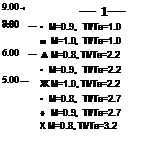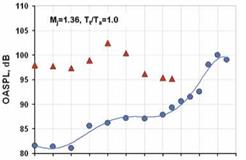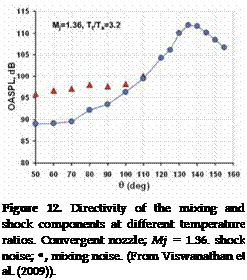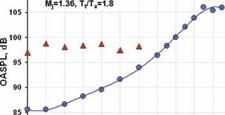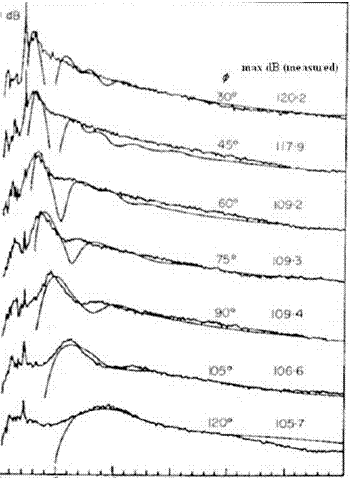A general theory for sound generated aerodynamically was developed by Lighthill (1952). He chose to formulate the problem by comparing the full equations of motion with the equations governing density fluctuations in a uniform acoustic medium at rest. The differences were considered to be the effect of a fluctuating force field, acting on the uniform acoustic medium, which would be known if the flow were known. Such an approach has been called an acoustic analogy, as it replaces the physical noise sources by a distribution of equivalent sources. Lighthill’s equation was introduced in Chapter 1. Here it is written as,
– a2 d2P = дТ (3)
dt2 o dxidxi Oxidxj
Tij, known as the Lighthill stress tensor, is the instantaneous applied stress at any point given by,
 Tij = pViVj + pij aopSij,
Tij = pViVj + pij aopSij,
where pij is the compressive stress tensor, given for a Stokesian gas by
p is the coefficient of viscosity and p is the thermodynamic pressure.
For low Mach number, unheated flows, Lighthill argued that Tij ~ poviVj where po is the constant mean density of the medium. It should be noted that the equivalent source term, d2Tijfdxidxj contains all physical effects such as convection and refraction. It is also important to note that vi is the instantaneous velocity: not a perturbation about a mean value. To overcome this problem to some extent it is possible to write the equations of motion in a frame of reference moving with the mean axial velocity, with the time derivatives replaced with convective derivatives and where the velocities are perturbations about the mean velocity. Then the Lighthill stress tensor is nonlinear in the fluctuations. This generalization of Lighthill’s acoustic analogy for sources embedded in a uniform mean flow is described by Dowling et al. (1978). Alternatively, the average of the equation can be subtracted from its instantaneous form. This approach has been used in more recent acoustic analogies.
In any event, the solution to Eqn. (3) can be obtained using the free space Green’s function for the wave equation,
where ті is the retarded time,
 Ті = t — |x – y|/ao
Ті = t — |x – y|/ao
In the far field where x = |x| >> |y|, Eqn. (6) becomes
If it is assumed that the velocity scales with the jet exit velocity Vj and that the time rate of change of the source term varies as Vj /£ where I is a characteristic length scale, it is readily shown that
where it has been assumed that t scales with the jet exit diameter dj and x ~ |x — y| in the far field. The far field intensity I (x), defined as the

 acoustic energy flux per unit area, is given by
acoustic energy flux per unit area, is given by
where ( ) denotes the time average value and Ma is the acoustic Mach number: the ratio of the jet exit velocity to the ambient speed of sound. This gives Lighthill’s famous eighth power law, that the total acoustic power output is proportional to
PoVfMld] (11)
Since the total mechanical power of the jet is proportional to poV^dj, the acoustic efficiency is approximately
(12)
The constant of proportionality can be estimated to be very small (of the order 10-4) so, fortunately, the acoustic efficiency is very low.
Lighthill (1954) applied his general theory to the sound generated by turbulence. He related the sound intensity in the far field to the statistical properties of the turbulent sources. To account for the effects of convection of the turbulent eddies in the jet, the statistical properties were described in a moving reference frame. Ffowcs Williams (1963) provided a more complete analysis of the effects of convection as well as the effect of the relative motion of the jet exhaust and the observer. He also showed how to remove an apparently singular result that occurs when the sources convect at the speed of sound in the direction of the observer. These results are most clearly developed in terms of the source wavenumber frequency spectrum. To see this, following Proudman (1952), the source component in the direction of the observer is introduced such that
T (xi – Vi)(xj – yj) T (13)
Txx = 2 1ij (13)
Iх – y|
This form is appropriate for isotropic turbulence. For statistically stationary turbulence the intensity can be obtained from the autocorrelation of the far field density in the form,
~ T +——— for |x| >> |y| (15)

 aQ aQ x
aQ aQ x
Rf (y, Д ,t) is the cross correlation of the Lighthill stress tensor, given by
Rf (y, Д, т) = (Txx (y, Ti) Txx (y + Д, ті + T)) (16)
where Д is the separation distance between the two source locations. The superscript f indicates that the correlation is performed in a fixed reference frame. The wavenumber frequency spectrum of the sources is defined as the Fourier transform of the cross correlation function. That is,
here, k and ш are a wavenumber vector and radian frequency respectively. Also, the spectral density of the intensity at the observer S (x, y), where 7 is the observer frequency, is given by the Fourier transform of the intensity,
S (x, Y) = 2П f 1 (x, T*) exp (-ijr *) dr * (18)
Then, it is readily shown that,
Equation (19) shows that the spectral density depends on an integral over the source volume of the frequency-weighted source wavenumber frequency spectrum. It is important to note that, for a given observer frequency y, only the wavenumber component of the source spectrum that has a sonic phase velocity in the direction of the observer contributes to the radiated noise. As discussed by Ffowcs Williams (1963), Crighton (1975) and Goldstein (1984), among others, this means that only a small fraction of the wavenumbers present in the turbulence can contribute to the noise radiation for convectively subsonic jets (Ma ^ 1.4).
In the practically important case where the convection is in the axial direction, a new coordinate is introduced such that
 5 = Д – Ucti
5 = Д – Ucti
where i is the unit vector in the xi, axial, direction. Then the far field autocorrelation for the intensity is given by
I S’ S’ d4
I (x, T*)= 16n2p a5 J J |1 – Me cos 0|-5 dT4Rm (y, 5,t) d5dy (21)
where
Rf (y, A, r) = Rm (y, 5,t) (22)
The superscript m refers to a correlation in the moving reference frame and в is the polar angle of the observer relative to the downstream jet axis. The integrand in Eqn. (21) is to be evaluated at
 5 ■ x/x + aoT* ao (1 – Mc cos в)
5 ■ x/x + aoT* ao (1 – Mc cos в)
and Mc = Uc/ao. If the wavenumber frequency spectrum in the moving reference frame is defined by
then the spectral density is given by
with
ш = y (1 – Mc cos в) (26)
It is important to remember that 5 = 5 (t) in the differentiation in the integrand of Eqn. (21): see Ffowcs Williams (1963). Again the radiated noise is at a wavenumber that gives a sonic phase velocity in the direction of the observer at the frequency Y: but, the source spectrum is now evaluated at a Doppler shifted frequency, ш given by Eqn. (26).
Source Cross Correlation Function In order to make any noise predictions, based on the preceding formulas for the spectral density, it is necessary to provide a model for the source cross correlation function. In addition, though the introduction of the Proudman (1952) form of the correlation in Eqn. (13) simplifies the algebra, it conceals the individual contributions of the different components of Tj. Ribner (1969) derived expressions for the relative weightings of the individual source correlations to the far field intensity for an axisymmetric jet. He assumed that the correlation involving the velocity fluctuations had a joint normal probability. This enabled {uiuju’ku’i) to be written in terms of the second moments (uiuj), etc.
Models for the source correlation function have been based on an assumption of isotropic turbulence (for example, Ribner (1969), Balsa and Gliebe (1977), Lilley (1995) and Lilley (1996)), axisymmetric turbulence (Khavaran (1999)), on measured two-point velocity correlations such as
|
‘ІХ 2 62 62
°1 , °2, °3 , , ,2 2 -( $ + <2 + <[3] + ^ T
|
those obtained by Davies et al. (1963) and Chu (1966), or based on Large Eddy Simulations (Karabasov et al. (2010)). For example, consider a source correlation in the moving reference frame with a Gaussian form2. That is,
ps, us, and us are density, velocity fluctuation, and frequency scales in the source region. < are the source length scales in the y directions. All these scales are functions of the source location У. It should be noted that this form is chosen for simplicity and is only a crude approximation to the actual cross correlation. So it should only be used to obtain estimates for the overall sound power radiated rather than detailed spectral densities and directivities. Lilley (1995) has argued that, though there may be large negative values in the longitudinal correlation in the fixed reference frame, the moving frame correlation is likely to be positive except at large separations. The wavenumber frequency spectrum corresponding to the correlation in Eqn. (27) is readily obtained and then Eqn. (25) yields the far field spectral density,
 S (X y) ■ 32^2 I tll2<2(У ) exp (-If) <iy
S (X y) ■ 32^2 I tll2<2(У ) exp (-If) <iy
|
(1 – Mc cos в)2 + (<2 cos2 в + <2 sin2 в)
|
where Cg is referred to as the modified Doppler factor given by,
The source strength in the denominator of the integrand in Eqn. (30) is weighted by five inverse powers of the modified Doppler factor. This is called the convective amplification effect. In general terms, this results in an increased intensity for observer locations closer to the downstream jet axis. However, this directivity is modified by mean flow-acoustic interaction effects. These are described in the next section.
Mean Flow-Acoustic Interaction Effects Lighthill’s simplification of his equivalent source term to povivj is valid for low Mach number unheated jets. Detailed measurements of jet noise spectra and directivity over a range of operating conditions by Lush (1971) and Ahuja and Bushell (1973), indicated that the theoretical predictions embodied in Eqns. (28) and (30) did not match the experiments: particularly at angles close to the downstream jet axis and at high frequencies. Atvars et al. (1965) had performed experiments with point sources embedded in a jet flow and showed that refraction effects by the jet flow were important. These experimental observations complemented attempts to extend Lighthill’s acoustic analogy to include the effects associated with the equivalent sources being surrounded by a moving, sheared flow. Phillips (1960) developed an acoustic analogy that included the effects of a uniform mean flow. However, it was Lilley (1972), Lilley (1973) who argued that the Phillips’ acoustic analogy still included mean flow acoustic interaction effects in its equivalent source term. Lilley developed an acoustic analogy such that the equivalent sources acted on a parallel shear flow. Lilley (1972), Lilley (1973) originally followed Phillips (1960) by first developing a convected wave equation for the logarithm of the pressure.
The equations of continuity, momentum and energy, and the equation of state for a perfect gas can be rearranged in the form
|
Dn dvi Dt dxi ’
|
(31)
|
|
and
where,
|
Dvi 2 dn Dt dxi, ’
|
(32)
|
|
П = bn (P) ,
Y Po /
|
(33)
|
|
and
|
D _ д d Dt dt j dxj
|
(34)
|
|
po is the mean static pressure that is assumed to be constant and a is the speed of sound that may vary. Phillips’ equation is obtained by elimination of the divergence of the velocity from Eqns. (31) and (32), giving
|
D2n d ( 2 dn ) dvj dvi
Dt2 dxi ( dxi) dxi dxj
If the variables in Eqn. (35) are decomposed into fluctuations about the mean thermodynamic properties and a parallel mean flow of the form ui =
V (x2,x3) 5ц is introduced, where the overbar denotes a time average, the term on the right hand side of Eqn. (35) is found to contain terms that are linear in the perturbations. Lilley (1972), Lilley (1973) argued that only terms that are second order in the fluctuations should be considered as equivalent sources, as linear terms describe propagation effects. If the convective derivative operator, Eqn. (34) is applied to Eqn. (35), the variables are again decomposed, and only linear terms are retained on the left hand side, Lilley’s equation is obtained,
The source term Г is at least second order in fluctuations of velocity and temperature and some terms are multiplied by the mean shear and temperature gradients. In the limit of infinitesimal fluctuations, the equation reduces to a homogeneous form first derived by Pridmore-Brown (1958) to describe sound propagation in a duct containing a nonuniform mean flow. It is also known as the compressible Rayleigh equation.
In general, solutions of Lilley’s equation must be obtained numerically. However, asymptotic solutions at low frequency were developed by Mani (1976) who used a vortex sheet approximation for the jet. A solution for a cylindrical vortex sheet representation of the jet mean flow was also given by Dowling et al. (1978). High frequency solutions have been obtained by Balsa (1976) and Goldstein (1982). Solutions based on ray acoustics are given by Durbin (1983).
The general characteristics of solutions to Lilley’s equation are explained most simply by considering a two-dimensional mean flow with V = V (y) as discussed by Lilley (1972). For simplicity, the speed of sound is assumed to be constant. If solutions of the form[4]
П ~ f (y) (1 – kM) exp [ik (kx – aot)], (38)
are introduced into Lilley’s equation, where M = V/ao, the equation takes the form
d2 f
df + q (y) f = r (y), (39)
where,
and r (y) is representative of the source distribution. The turning points of Eqn. (39) correspond to q (yc) = 0. For q (y) > 0 the general solutions are periodic and propagation will occur. For q (y) < 0 the solutions decay exponentially. At high frequencies q (y) is dominated by the first term. Now, к = kl/k = cos в is the angle of radiation relative to the downstream jet axis. It is readily shown that the turning points correspond to
 вс = 1/(1 + M)
вс = 1/(1 + M)
For в < вс the sound experiences exponential decay away from the source while for в > вс the sound waves are able to propagate. вс is the boundary of the zone of silence of geometric acoustics. This is equivalent to Snell’s law in optics.
Since, in a real jet, the flow is not truly parallel, but develops slowly in the axial direction, вс also changes with axial distance. Also, a sound wave may only experience exponential decay for a portion of its propagation path before radiating. Finally, the simple result of Eqn. (41) is only true at very high frequencies. All these factors result in a zone of silence that is not completely silent. The greatest attenuation and refraction occurs for the highest frequencies and low frequencies are relatively unaffected.
Noise Prediction Models Based on the Acoustic Analogy In spite of the considerable effort expended on theoretical developments arising from the acoustic analogy, actual noise prediction methods are scarce. At the simplest level some general scaling laws have been developed. These are well summarized by Ribner (1964) and Lilley (1995). An example is the ‘slice-of-the-jet’ method in which contributions to the overall radiated power from axial slices of the jet are estimated. For example, Eqn. (30) can be integrated over all angles, with the convective amplification effects neglected for simplicity, to give the radiated power from a volume element of the jet as,
dP – ^ dV (42)
a,%
Here, it has been assumed that the source length scales are all proportional to £s, that the source density is equal to the ambient density, and that us ~ us/£s. In the annular mixing region of the jet, us ~ Uj, dV ~ Djxdx,
and £s ~ x. In the developed region of the jet, us ~ UjDj/x, dV ~ x2dx, and £s ~ x. So that,
dP f (poUjDjfa50) in the annular mixing region
dx (p0UjDj/a0o) (x/Dj) 7 in the developed jet
Thus, the contribution to the radiated power from each axial slice of the jet is constant in the annular mixing and then decays rapidly beyond the end of the potential core. If these expressions are integrated with respect to x, the eighth power law given by Eqn. (11) is obtained. Since us ~ us/£s, the characteristic source frequency scales as Uj /x in the annular mixing region and as Uj Dj /x2 in the developed jet. Then the spectral density of the acoustic power is given by,
 dP dP dx df dx df
dP dP dx df dx df
(44)
Thus, the acoustic power spectrum is predicted to scale as f 2 at low frequencies (generated predominantly in the developed jet) and f -2 at high frequencies(generated near the jet exit in the annular mixing region). These results give an indication of the regions of the jet responsible for sound generation and provide an overall picture of jet noise scaling and are useful for preliminary design estimates. But they do not predict absolute amplitude and mean flow/acoustic interaction effects are not included.
The first method to attempt to predict both the aerodynamic and acoustic properties of jets was the Mani-Gliebe-Balsa (MGB) prediction scheme (see Balsa et al. (1978)). In this method the jet aerodynamics were predicted using the turbulence model of Reichardt (1941) in which the jet plume is synthesized by a summation of elemental jets each with a Gaussian velocity profile. Comparisons of the aerodynamic predictions with measurements are given by Gliebe and Balsa (1978) as well as Gliebe et al. (1995). To obtain the characteristic frequency and length scales needed to describe the acoustic sources, such as those in Eqn. (28), two models were used. Balsa and Gliebe (1977) assumed that ш ~ (r/p)1/2/£ with I ~ (x/u)(r/p)1/2. Here, т is the magnitude of the Reynolds shear stress that is given by Reichardt’s turbulence model and U is the mean axial velocity. Gliebe and Balsa (1978) assumed that ш was proportional to the local mean velocity gradient and £ ~ u’/ш, where u’ is the local turbulence intensity. Mean flow acoustic interaction effects were modeled using solutions to Lilley’s equation [Eqn. (36)] with the multistream jets modeled as cylindrical vortex sheets. Similar solutions had been obtained by Mani (1976) and Balsa (1975). The
relative contributions from the individual components of the source term were based on the quadrupole correlations developed by Ribner (1969) that assumed isotropic turbulence in a moving reference frame. Some comparisons between predictions and measurements are given by Balsa and Gliebe (1977) and Gliebe and Balsa (1978). The agreement between predictions and measurements is generally reasonable, though significant discrepancies are evident in the directivities at higher frequencies and the individual 1/3 octave spectra at different angles.
A different prediction methodology developed from the noise source and propagation model is described by Tester and Morfey (1976). The emphasis of this study was on the prediction of the mean flow/acoustic interaction effects on the sources described by Lilley’s equation. They derived both high frequency (Geometric Acoustics) and low frequency solutions to Lil – ley’s equation. This analysis led to the notion that if the noise spectra at 90 degrees to the jet axis were known then the noise spectra at any other angle could be predicted using their acoustic model. Morfey and Szewczyk (1977a), Morfey and Szewczyk (1977b) used a large database of experimental data and removed all amplitude scaling factors and mean flow/acoustic interaction effects as described by a high frequency solution to Lilley’s equation. This enabled them to construct two master spectra representing the spectral shapes at 90 degrees to the jet axis. They needed two spectra to be able to correlate the spectra for hot, low speed jets, where sources associated with the temperature fluctuations in the jet were argued to be important. However, as discussed by Viswanathan (2004), and shown in Figure 15, the change in spectral shape at low Mach numbers can be associated with a Reynolds number effect. Morfey and Szewczyk (1978) give a summary of their predictions for noise radiation outside the zone of silence. Predictions within the zone of silence, described by Morfey and Szewczyk (1977b) were less satisfactory, particularly for very high speed jets. However, no account of the noise radiation by the large-scale structures was included in their model, so this result is perhaps not surprising. It should be emphasized that this model was purely acoustic in that it didn’t attempt to predict any turbulence properties to be used to model the noise source characteristics. Any changes in the jet turbulence, perhaps by the addition of a noise reduction device, would not be reflected in the noise predictions as the master spectra were developed for an unmodified single jet. Morris and Tanna (1985) were able to adapt the model to predict the noise radiated by coannular jets with the core stream faster than the fan stream. They did this by dividing the jet into three equivalent jets to represent the inner and outer shear layers and the developed region of the jet. Good agreement with experiment was obtained using reasonable assumptions for the properties of
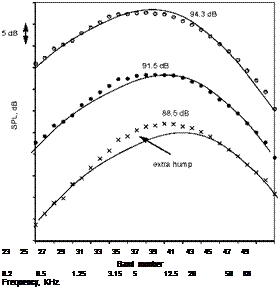 |
Figure 15. Comparison of measured spectra with fine-scale similarity spectrum. M = 0.7, Tt/Ta = 3.2, ф = 90 degrees. x, D = 3.81 cm; •, D = 6.22 cm; O, D = 8.79 cm.(From Viswanathan (2004), with permission).
the separate jets.
In an effort to improve the generality of the aerodynamic component of the MGB code, Khavaran et al. (1994) replaced Reichardt’s turbulence model with a к – є model. This revision and its extensions are known as the MGB-Khavaran (MGBK) model. The acoustic formulation in terms of source description was unchanged but the mean flow/acoustic interaction effects were based on high frequency solutions of Lilley’s equation by Balsa (1976). The length and frequency scales required to define the source spectral characteristics were written in terms of к and є such that I ~ к3/2 /є and ш ~ є/к. Flow and noise predictions were made for a single C-D nozzle with Mj = 1.4 and Tt/Ta = 3.3 The variation of overall SPL was predicted reasonably well: but 1/3 octave spectra predictions, particularly away from the peak noise direction, were less satisfactory. Two additional changes were reported by Khavaran (1999). Firstly, rather than using an isotropic description of the acoustic sources, an axisymmetric turbulence model was
incorporated. In such a model, the axial turbulence intensity is assumed to be greater than the other two components that are equal. This is a better representation of the measured anisotropic properties of the turbulence in the jet. Noise and flow predictions were made for a dual stream nozzle. The primary and secondary Mach numbers and total temperature ratios were Mp ~ 1.0, Ttp/Ta = 2.7 and Ms ~ 1.0, Tts/To ~ 1.0. Khavaran examined the effects of the ratio of the axial and lateral turbulence intensities on the radiated noise as well as the contributions of “self” and “shear” noise. The predictions showed an improvement over the previous ones ( Khavaran et al. (1994)), particularly for the 1/3 octave spectra. However, the revisions in the source description permitted two more empirical factors to be assigned: the ratios of the turbulence intensities and the length scales in the axial and lateral directions.
Viswanathan (2001) describes a comparison of predictions of single stream jet noise with measurements, using both the MGBK method and the fine-scale turbulence mixing noise model by Tam and Auriault (1999). This latter model, as well as additional recent prediction models, is described in Section 3.4 below. The predictions were made without any prior access to the experimental data. In general, the spectral predictions with the Tam and Auriault model were superior to those made with the MGBK method. However, as discussed further in Section 3.4, the fine-scale turbulence model does not provide predictions in the peak noise direction. Tam and Auriault (1999) argue that the noise radiation in this direction is dominated by noise from the large-scale turbulent structures. The mechanism by which this noise generation and radiation process occurs and its modeling are described in the next section.














